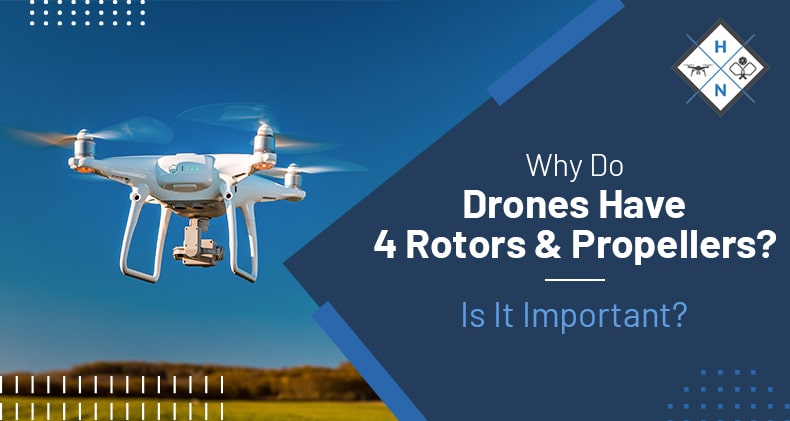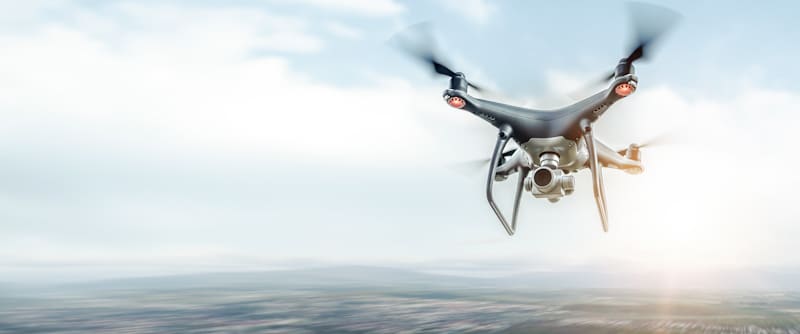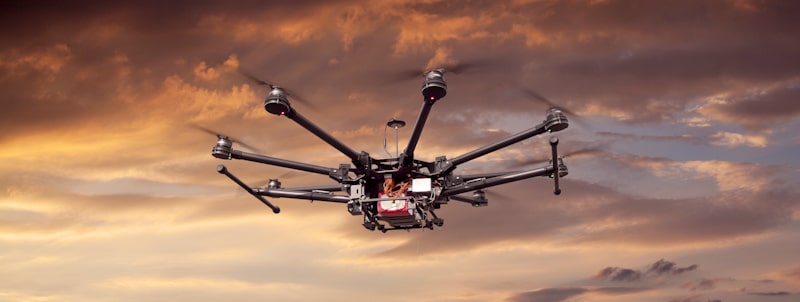In order to fly, all drones require propellers. However, most drones today are categorized as quadcopters and this is another way of saying they have four propellers. So have you ever wondered why drones have four propellers in particular?
In a nutshell, unlike helicopters, drones or quadcopters are void of the streamlined system or ability to use a single rotor. Consequently, the best and cheapest way to make a drone fly is to stabilize and lift the drone using 4 points of thrust or four propellers.
How Do Drones Actually Work?
There are a few factors at play when it comes to making a drone fly. For instance, in conjunction with the drone's motor speed and rotation, the direction of the propeller is what makes it take flight. Therefore these consolidated factors make a drone fly and maneuver.
The flight controller on the drone sends information to the motors RPM, or revolutions per minute and lets it know the direction to go. As most people know, drones' technology is highly advanced, and drones are basically classified as modern machinery. However, they still make use of previous concepts of aircraft action, gravity, light, and the reaction pairs.
So, How Do They Fly?
A signal is sent to the central flight controller when the joystick is moved. This information is then sent by the central flight controller to the electronic speed controllers, which are found in each motor. The signal then leads the motors to either increase or decrease the pace of the propellers when the signal is sent.
Why Does This Design Work?
The mechanical simplicity that drones contain is one of the reasons why they are so sought after and also easy to make. It consists of four fixed pitch propellers that are all connected to the four propellers and contain a single moving part or point, and this is why the design of the quadcopter is so simple. This is also another reason why drones are cheap or economically priced.
Do Drones Need Propellers?
Like any other price of modern technology, drones are consistently and constantly improving each day. As more advanced technology becomes available, it will be added to drone tech to improve its overall performance.
As much as drones are loved and sought after by people all over the world, they still have much room to be improved. This is why there are people and companies out there trying to improve the way drones are designed.
Currently, there are individuals that have designed drones to fly and work differently from the traditional propeller approach.
Some of these models contain centrifugal fans, also referred to as impellers, rather than propellers. These impellers create thrust, but you are probably asking how do these types of drones work?
In simple terms, it works much like a leaf blower. However, the air is pulled from the side and pushed downwards instead of being pulled from the back and out of the front like a leaf blower.
Just as common drones use propellers to produce thrust and push the drone off the ground, this model uses impellers to do the same but using the leaf-blower design. So it works by redirecting air towards the ground for the drone to take flight.
Can a Drone Fly Using Three Propellers?
Drones are available in all colors, sizes, and shapes, from multi-rotor systems and lots of propellers to quadcopters.
Depending on your specific design of the drone, if it loses a propeller after taking flight, it could lead to either one of two scenarios.
In the first instance, the drone could come crashing down from high altitudes, or alternatively, it will have a very wobbly landing back to you. The drones that still fly even after damaging a propeller usually contain a multi-rotor system which makes them more steady even when using a propeller.
Crashing or landing the aircraft, ultimately depends on the center of gravity and where it is situated and where the thrust is produced. This is why quadcopters are not designed to take flight with only three propellers, and this is why even after losing one of the four propellers, it will consequently lose its balance.
Drones contain four propellers containing the center of gravity that is seated inside a box produced by the four propellers. And this is where the load can usually be located. While flying, if the drone fails or breaks, the box produced by the motors and the propellers' four points creates a triangle. The drone may still stay suspended in the air continue or worst-case scenario, land safely if the load is sitting within the triangle.
Since there are two propellers that are completely operational, it will carry most of the load, but the truth is that it will obviously still be off-balance. This is due to the balance of the load being held by the non-operational propeller. Basically, you can simply forget about the drone flying if there is even a little bit of wind. It's highly likely that the unmanned device will spin out of control due to the absence of the fourth propeller, which is designed to keep the balance.
So the best advice is to opt for a controlled crash landing in the event that you break a propeller for whatever reason. So while the drone is not going to automatically drop from the sky after losing one of its four propellers, it's definitely not going to stay in the air for a long time.
Octocopters and Hexacopters, on the other hand, have additional propellers than quadcopters, and therefore even if they are still in flight and lose a single propeller, this won't affect the drone's chances of staying in the air. This is because there are multiple propellers to keep it suspended. So while the flight may not be the smoothest, neither will the images or videos be the greatest, as a consolation, the drone will still return to you.
Hexacopters and Octocopters
Hexacopters
So we all know that the quadcopter is a drone containing four propellers but what exactly is a hexacopter? Well, this is also a remote-controlled device or UAS; however, it contains six propellers instead of four. The six propellers are located above the main body of the hexacopter and are laid out in a circular shape.
Hexacopters usually have cameras and also feature two legs which can be likened to skis. Ultimately, the skis are what allows the device to be stable when landing. Due to the six propellers, this device has more flying power and also maneuverability. It can fly sturdier and also reach high-altitudes than a quadcopter due to its design and number of propellers.
It also has more lifting power, and it's also going to capture fantastic camera footage, especially if you have a high-quality camera that you're using with this device.
What We Like
One of the advantages that hexacopters have over quadcopters is that it can continue to fly even if it loses one of its propeller blades. The motors that power the propellers are placed 120° apart from each other, so if one fails, the other five can continue to keep the aircraft airborne. So you don't need to worry about your camera falling off the drone because even in the event of a propeller failing, it will still manage to land safely without any issues.
So what happens if a hexacopter loses two propellers? Well, it can still land safely even after losing two of its propellers. This is because it will still have four propellers which are equivalent to the number of blades on a quadcopter, and if a quadcopter can fly perfectly well with only four propellers, there is no reason why a hexacopter shouldn't do the same.
So, in a nutshell, the hexacopter will still stay in the air effectively even after losing two of its propeller blades. Hexacopters achieve higher attitudes than quadcopters. The additional propellers also give it more lifting power than quadcopters, and they can fly faster than quadcopters.
Ultimately, all of these features and benefits are a result of the additional propellers. As a bonus, the hexacopter also delivers more load-carrying capacity than quadcopters. So mounting a high-performance camera on the hexacopter is no problem at all, thanks to its increased capacity to carry a heavier payload.
What We Don’t Like
Since Hectorcopters are overall more efficient devices than quadcopters, it's also consequently more expensive to make. The extra propellers cost more, and hexacopters are larger than quadcopters. In the event that the rotors are damaged, hexacopters are more expensive to replace or repair.
Octocopters
If you thought that a hexacopter had a lot of rotors, then the octocopter is in a league of its own. The Octocopter contains a whopping eight rotors and fully functioning propellers. Each of these propellers is powered by a motor, so an octocopter contains eight motors as well. Consequently, these devices have more flying capabilities than both quadcopters and hexacopters. So to give you an idea of how efficient these devices are, simply combine the maneuverability, uplift power, and flying speed of a quadcopter and hexacopter, and you get the performance of an octocopter. They are also extremely stable as they remain suspended or flying in the air, and consequently, they are capable of recording high-quality images and videos from any altitude. This is why they are the preferred choice of professional videographers and explorers alike. These professionals use octocopters to capture images and video footage of anything from wildlife and landscapes to live events.
What We Like
As we mentioned earlier, the octocopter is superfast. This is due to the many propellers, which give it great uplift power and acceleration. They are consequently faster than both quadcopters and hexacopters. The speed that they deliver does not compromise control. Due to the multiple propellers, the pilot has complete control over the aircraft at any given time. When it comes to strong winds or even rain, the octocopter can fly right through these elements. Even if it loses some of its propellers, the drone still has the ability to remain in the air for longer than a quadcopter or hexacopter.
So even if it loses two or three of its propellers, it can still stay suspended in the air. One of the main advantages of an octocopter is that it can remain in flight even with four or five motors.
In the event that you prefer using premium quality cameras such as the GoPro for drones, the octocopter is recommended. It's the safest bet and has really amazing engine control, hovering ability, and stability. They can also reach dizzying heights, and it's agile enough to change direction in a heartbeat.
This is why octocopters are the preferred choice when it comes to shooting motion picture pieces and movies. They are also capable of carrying heavy payloads and can carry extra batteries and cameras; due to their load capacity. These drones can be used to transport materials from one place to another as well.
What We Don’t Like
One of the drawbacks of using an octocopter is that the device is quite large. It's quite a bulky flying machine, and this is obviously due to the eight propellers and motors. So when transporting it, you need to proceed with caution.
The device is also not easy to manufacture or cheap, for that matter. This is because the motors are extremely high-powered and therefore expensive to procure. So once an octocopter is broken, it's going to cost you an arm and a leg to either repair or replace it.
It also consumes quite a lot of power and this results in low-flying time. Due to the amount of power needed to keep these aerial devices suspended in the air, the first generation of octocopters didn't have the ability to stay suspended for more than 10 minutes.
As of lately, octocopters have been improved to have more flying time but not for long periods of time. As such, you need to carry extra batteries when using them or recharge them frequently.
Conclusion
So as you can see, the hexacopter and octocopter have many advantages over a quadcopter. So if you already own a quadcopter and want to take your drone flying experience to the next level, why not go for a premium range hexacopter or octocopter to truly enhance your aeronautical experiences.
Shawn Manaher loves to play with new toys and dive into new hobbies. As a serial entrepreneur, work definitely comes first but there is always room for hobbies.





